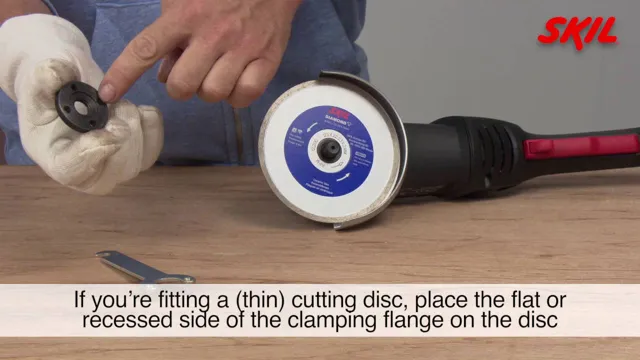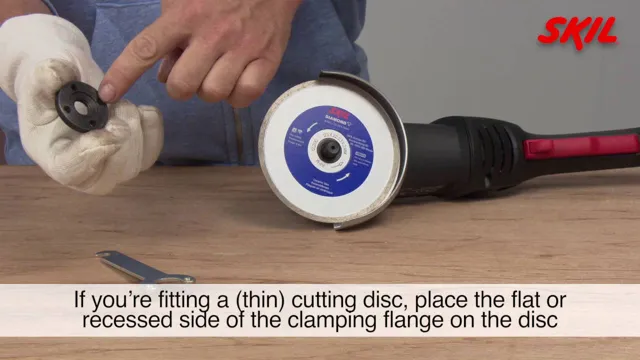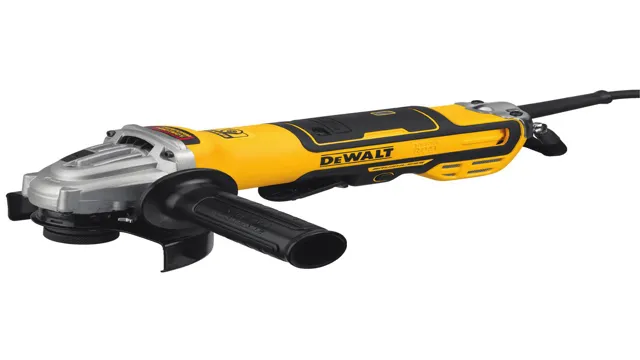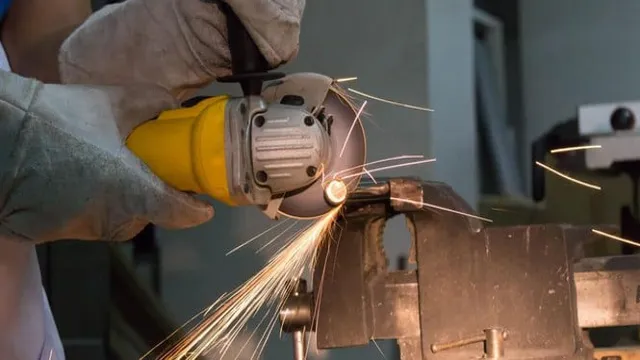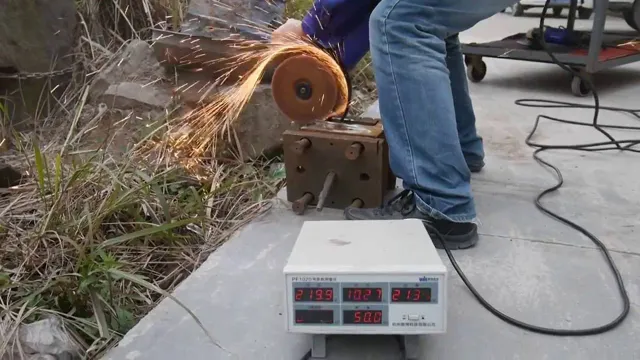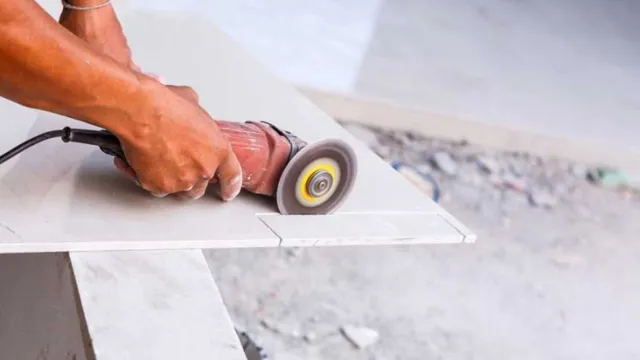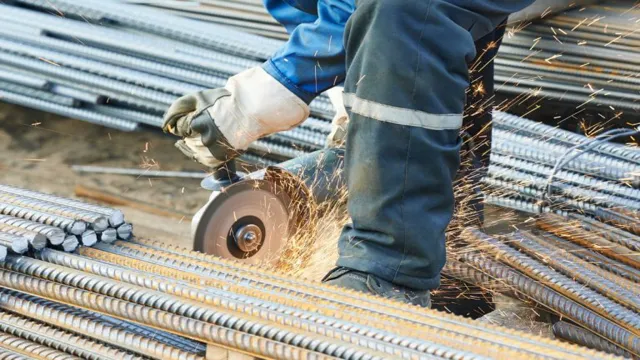How to Choose the Right Angle Grinder: A Comprehensive Guide for DIY Enthusiasts
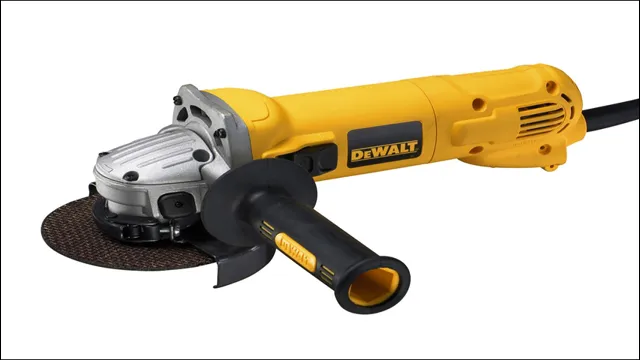
Are you in the market for a new angle grinder, but are unsure of where to start? Don’t worry, you’re not alone. Choosing the right angle grinder can be a daunting task, especially if you’re a beginner or unfamiliar with the different options available. However, with a little bit of knowledge and guidance, you can easily select the perfect angle grinder for all your needs.
An angle grinder is a versatile tool that can be used for a variety of tasks, from grinding and cutting to polishing and sanding. However, there are several factors to consider when choosing the right angle grinder for your specific needs. Some of these factors include the size of the grinder, the type of disc it uses, and the power source.
One of the first things to consider is the size of the grinder. Angle grinders come in various sizes, ranging from small, handheld models to large, heavy-duty machines. A smaller grinder may be ideal for simple tasks or projects that require a high degree of precision, while a larger grinder may be necessary for larger or more complex projects.
Another important factor is the type of disc the grinder uses. Angle grinders can use a variety of discs, including cutting discs, grinding discs, and polishing discs. Each disc is designed for a specific task, so it’s crucial to select the right one for your needs.
Additionally, it’s important to choose a durable disc that can handle the demands of your project. Lastly, it’s important to consider the power source of the angle grinder. While some grinders are corded, others may be cordless and powered by batteries.
Cordless grinders offer increased mobility and convenience, but may have a shorter lifespan than corded models. Corded grinders, on the other hand, offer more power and durability, but may be less convenient to use. In summary, when choosing the right angle grinder, it’s important to consider the size of the grinder, the type of disc it uses, and the power source.
Consider the Size and Power Requirements
When looking for the right angle grinder, you’ll want to consider the size and power requirements. The size of the disc will determine the depth and speed of the cut, and the power of the motor will determine how fast the disc spins. Generally, larger discs will be able to make deeper cuts, but they’ll also require more power to drive them.
Similarly, a more powerful motor will be able to spin a bigger disc faster, but it will also draw more electricity and be heavier to use. So, depending on the type of work you’ll be doing, it’s important to find a balance between disc size and motor power. Consider what materials you’ll be working with, and how much power you’ll need to complete the job efficiently.
By understanding the size and power requirements, you’ll be able to choose an angle grinder that meets your needs and gets the job done right.
Evaluate the Size of Your Project
When starting a new project, it’s important to consider the size and power requirements of your intended end product. Will your project be a small-scale prototype or a large-scale industrial application? Determining the appropriate size and power requirements of your project is vital in ensuring its success. Not only will it affect the cost of your project, but it will also impact the complexity and number of components needed and the overall functionality of the end product.
It’s essential to choose the right power source to ensure your project functions as intended, whether that be battery-powered or mains-powered. Ultimately, properly evaluating the size and power requirements of your project will help you avoid costly mistakes and ensure that your end product is efficient, reliable, and meets the needs of your intended use.
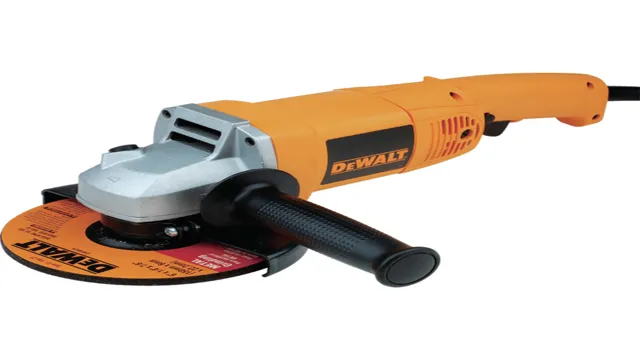
Match Disc Size to Grinder Size
When it comes to choosing the right grinder and disc size, it’s important to consider both the size and power requirements. Matching the disc size to the grinder size is crucial for achieving optimal results and preventing damage to your tool. The disc size refers to the diameter of the grinding or cutting wheel and is measured in inches.
The grinder size, on the other hand, refers to the power rating of the tool and is measured in amps. A general rule of thumb is that the disc size must be smaller than the grinder size. Using a larger disc with a smaller grinder can lead to unsafe or ineffective operation, while using a smaller disc with a larger grinder can cause excessive wear and tear on the tool.
It’s essential to choose a disc size that suits the specific application and material you’ll be working with. By carefully matching the disc size to the grinder size, you’ll be able to achieve maximum efficiency and a longer tool lifespan.
Determine Power Needs Based on Material
When it comes to determining power needs based on material, one of the most important factors to consider is size and power requirements. Different types of materials have different densities, hardness, and thicknesses, which can affect the amount of power needed to process them. For instance, while softer materials like wood and plastics may require less power, harder materials like metals or ceramics will require greater power and more specialized equipment to handle.
Additionally, the size of the material can affect power needs, since larger material will require more power to process than smaller ones. Therefore, it’s vital to take into account the size and material of the project when determining the power requirements to ensure the machine or tool can efficiently handle the workload. By considering the size and power requirements when selecting the correct equipment, you can make your work more efficient and save time and money.
Check for Safety Features
When selecting an angle grinder, it is important to ensure that the tool comes equipped with proper safety features. This includes a safety guard that serves as a shield between the user and the rotating disc, preventing debris and sparks from flying towards the operator. Additionally, grinders should have a lock-on switch to prevent accidental startup, and a handle that provides a secure and comfortable grip.
As you research different models, make sure to check that safety features are included and meet your personal needs. Choosing an angle grinder with these safety measures can provide peace of mind and help prevent accidents while using these powerful tools. Remember, when shopping for an angle grinder, prioritize safety first and foremost.
Look for Guards and Handles
When it comes to selecting a product to buy, safety is a top concern for everyone. It is important to look for guards and handles of the product that you are investing in because they offer an extra layer of protection. If the product has sharp edges or moving parts, make sure it has a guard that will prevent accidents from happening.
Handles provide a secure grip and reduce the chances of dropping the product and injuring yourself or others. Safety features on a product prevent accidents and injuries, which is why they are vital and should be a top priority. When shopping for a product, don’t forget to check for these essential safety features as they play a significant role in keeping you and those around you safe from harm.
So always pay extra attention to the details and choose products that have these features for a safer and better experience.
Check for Automatic Shut-off
While utilizing kitchen appliances, it’s crucial to check for safety features to prevent any accidents. One of the essential safety features is automatic shut-off, which ensures the appliance turns off once it reaches a specific temperature or after a certain amount of time. This feature is particularly important for appliances that generate heat, such as rice cookers, electric kettles, and coffee makers.
In case you forget to turn off the appliance or leave it unattended, the automatic shut-off feature will protect you from fires and other potential hazards. It’s always better to be safe than sorry, so when you’re shopping for kitchen appliances, make sure to prioritize safety features such as automatic shut-off.
Select a Grinder Type
Choosing the right angle grinder can be a daunting task. There are various types of grinders on the market, each designed for specific uses. Before you buy, consider what tasks you intend to use the grinder for.
For instance, if you plan to use it for cutting metal or concrete, then a diamond disc grinder is ideal. However, if you need to polish or sand materials, then a wired or cordless angle grinder is more suitable. Ensure that you also consider the grinder’s disc size and speed before purchasing.
A smaller disc is perfect for tight spaces, while a bigger one is more versatile and can handle heavy-duty tasks. A medium to high speed grinder is great for cutting and grinding tasks; however, a low to medium speed angle grinder is best for polishing and sanding jobs. When choosing an angle grinder, rely on a reputable brand, read customer reviews from other users, and seek advice from experts.
With these factors in mind, you’ll be better equipped to choose the right angle grinder for your needs.
Corded vs Cordless
When it comes to choosing a grinder, there are two main types to consider: corded and cordless. Corded grinders offer consistent power and are ideal for tasks that require continuous use, such as cutting and grinding tough materials. However, they require an electrical outlet, making them less portable and limiting their range of use.
On the other hand, cordless grinders offer more flexibility as they do not require any cords or outlets, allowing users to work in any location. These grinders use batteries to run, which can limit the power output and require frequent recharging. The choice between corded and cordless grinders ultimately depends on the intended use and preferences of the user.
If portability is a priority, a cordless grinder may be the better option. However, if consistent and reliable power is essential, a corded grinder may be the best choice.
Paddle Switch vs Trigger Switch
When it comes to selecting a grinder, one of the key decisions you’ll need to make is whether to opt for a paddle switch or a trigger switch. Paddle switches are located on the top or side of the grinder and are activated by pressing the switch down with your finger. Trigger switches, on the other hand, are located on the handle of the grinder and are activated by pulling the trigger with your finger.
One of the benefits of paddle switches is that they can be easier to operate for individuals with mobility or dexterity issues in their hands. Paddle switches are also less likely to get inadvertently activated if the tool is dropped or bumped. However, trigger switches offer more precise control over the tool and can be easier to grip during extended use.
Ultimately, the decision between paddle and trigger switches will likely come down to personal preference and the type of work you’ll be doing with your grinder. If you need precise control over your tool, a trigger switch might be the better choice. But if you’re looking for a simple, easy-to-use option, a paddle switch might be the best fit.
Regardless of which option you choose, be sure to select a high-quality grinder that meets your specific needs and budget constraints.
Make Sure the Grinder is Comfortable to Use
When choosing an angle grinder, it’s important to ensure that it’s comfortable to use. This may seem like an afterthought, but it can make a huge difference when you’re using the grinder for extended periods of time. Look for grinders with ergonomic handles that fit comfortably in your hand, and make sure that the weight is evenly distributed.
If the grinder is too heavy or unbalanced, it can quickly become tiring to use. Additionally, pay attention to the vibration levels of the grinder. Higher levels of vibration can cause discomfort and even lead to repetitive strain injuries.
Choosing a grinder with a low vibration level can help prevent these issues and make your work more enjoyable. Remember, a comfortable grinder allows you to work for longer periods of time, which can ultimately increase your productivity.
Check the Weight and Grip
When you are looking for a grinder, it is important to check the weight and grip of the tool. A grinder with the right weight and grip can ensure safe and comfortable use. A lightweight grinder is easy to handle and causes less fatigue when using it for extended periods.
On the other hand, a grinder that is too heavy can be difficult to use and can cause strain and discomfort. Additionally, the grip of the grinder should be comfortable and secure. A grinder with a slip-resistant grip can reduce the chances of accidents happening even when your hands are sweaty or oily.
When it comes to grinding, you want to have maximum control over the tool, and a comfortable grip ensures better accuracy. Therefore, when looking for a grinder, make sure you check the weight and grip of the tool to ensure that you have a comfortable and safe grinding experience.
Consider Vibration Control
When it comes to using a grinder, one of the most important factors to consider is vibration control. The last thing you want is for your hands and arms to become fatigued or even injured from prolonged use. That’s why it’s important to invest in a grinder that offers some level of vibration control.
This could include features like anti-vibration handles, rubber grip pads, or even an internal dampening system. Not only will this make the grinder more comfortable to use, but it will also help improve your accuracy and overall results. So, when shopping for a grinder, make sure you keep vibration control in mind as a crucial factor to consider.
Your body will thank you for it!
Read Reviews and Compare Brands
When choosing the right angle grinder, it’s important to read reviews and compare different brands to ensure that you get the best possible tool for the job. Firstly, consider the size of the grinder, as this can affect its versatility and compatibility with different accessories. Another important factor is the power of the grinder, which will determine how quickly and efficiently it can cut through materials.
Look for grinders with a high power output and variable speed settings for greater control. When comparing brands, consider the durability of the tool, the quality of the materials used, and the customer support offered by the manufacturer. Look for brands with a proven track record of reliability and customer satisfaction.
With careful consideration of these factors and thorough research, you can choose an angle grinder that will meet your needs and provide long-lasting performance. So, make sure to read reviews, compare brands, and choose the right angle grinder for your needs.
Research Specific Models and Brands
When it’s time to buy a new car, doing your research is key to ensuring you make the right choice. With so many models and brands out there, it can be overwhelming to decide which one is right for you. That’s why it’s important to read reviews and compare brands before making a decision.
Spend some time researching specific models and brands that catch your eye, and read through customer reviews to get a better sense of how they perform in the real world. Compare the features, safety ratings, and prices of each brand to get a better sense of which one might be the best fit for your needs and budget. By taking the time to do your research, you’ll be able to find a car that meets your specific needs and preferences, and you’ll feel confident in your purchase decision.
So start your research today, and get ready to find the perfect car for you!
Take into Account Durability and Warranty
When it comes to shopping for appliances, it’s important to consider both durability and warranty. One way to determine the durability of an appliance is to read reviews from other consumers who have already purchased and used the product. Look for feedback and comments regarding the appliance’s longevity and sturdiness, as well as any potential problems or malfunctions that have been reported.
Another important factor to consider is the warranty offered by the brand. Be sure to carefully read and compare the warranties of different brands, taking note of what is covered and for how long. It’s also important to keep in mind that a longer warranty does not necessarily equate to a more durable appliance.
Therefore, it’s essential to research and compare brands to ensure that you choose an appliance that not only has a solid warranty, but also a reputation for durability. By doing so, you can make a well-informed decision and feel confident in your purchase.
Conclusion: Choose the Right Angle Grinder for Your Needs
Choosing the right angle grinder might seem like a daunting task, but with the right approach, it can be a breeze. Think about what you’ll be using it for and choose a model with the appropriate power and disc size. Consider the features and extras that will make your work easier and safer.
And don’t forget to factor in your own personal preferences, like weight and grip. Armed with this knowledge, you’ll be able to make a sharp decision and unleash the cutting power of the right angle grinder.”
FAQs
What factors should I consider when choosing an angle grinder?
When choosing an angle grinder, consider factors such as power, disc size, and safety features. It’s important to choose a grinder that fits your specific needs and is well-suited to the tasks you’ll be using it for.
Should I choose an electric or pneumatic angle grinder?
Electric angle grinders are more commonly used, as they are easier to find and tend to be less expensive. However, pneumatic angle grinders are often more powerful and can be better choices for heavy-duty grinding tasks.
What is a good disc size for an angle grinder?
Disc size will depend on the specific task you’ll be using your angle grinder for. Smaller discs, typically around 4-1/2 inches, are good for general-purpose grinding and cutting. Larger discs, such as 7 inches or more, are better suited for heavy-duty grinding tasks.
How do I choose the right angle grinder for metalworking tasks?
When choosing an angle grinder for metalworking tasks, consider factors such as disc size, motor power, and the ability to attach accessories such as wire wheels and sanding discs.
Can I use an angle grinder for cutting concrete?
Yes, angle grinders can be used for cutting concrete, but you’ll need a specific type of disc designed for this task. A diamond-tipped cutting disc is the best choice for cutting through concrete with an angle grinder.
What safety features should I look for when choosing an angle grinder?
Look for safety features such as a safety lock-off switch, a spindle lock, and an adjustable guard. These features help to prevent accidental startup and protect you from flying debris.
How should I maintain my angle grinder?
Regular maintenance is essential for keeping your angle grinder in top condition. Clean the tool after each use, check the disc for signs of wear or damage, and lubricate any moving parts as needed.

